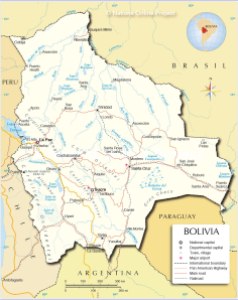For general information about the country profiles click here.
 Population: 10,496,285
Population: 10,496,285
HDI ranking: 108/187
HDI score: 0.675
Democracy was restored to Bolivia in 1982 (IRI), and the new constitution of 2009 accelerates decentralization plans, making Bolivia one of the most decentralized countries in the region (Carnegie, 2011).
Local governance at a glance
Vice Ministry of Popular Participation
- Bolivia is divided into:
- 9 Departments
- 112 Provinces
- 327 Municipalities
- 1374 Cantons or Territories of traditional peoples
- The people directly elect the mayor and councilors who oversee the functions of municipalities.
- Each canton decides upon one person to represent the citizens on the Vigilance Committee. Their duties include overseeing the budget and expenditure (Hadenius, 2003).
Civil society actors include
- The Bolivian Foundation for Multiparty Democracy (FBDM) hosts workshops, discussions and provides information regarding democracy and pluralism. The mission of the organization is to create and strengthen democratic paradigms among Bolivian political parties.
- Support for the Indigenous of Eastern Bolivia (Apoyo Para el Campesino-Indígena del Oriente Boliviano) educates the indigenous peoples of Eastern Bolvia about their political rights and culturally contextual development projects.
- The Participation and Justice Network connects civil society actors in Bolivia striving toward a more democratic and fair system of governance.
- Centro de Investigación y Promoción del Campesinado (CIPCA) work toward a more democratic and fair country by promoting the rights of indigenous peoples in the political sector.
Capacity building institutions
- The Law of Popular Participation, announced in 1994, came at a time when local government in Bolivia was relatively non-existent. This law established a new standard for resource allocation, mandating 20 percent of national tax revenue to be transferred to municipalities; more responsibilities regarding health and infrastructure shifted to the municipalities; local representatives oversaw decision making processes; lastly, additional municipalities were created to include suburbs and rural areas (Development Research Centre, 2003).
- The Law of Political Parties granted civil organizations and indigenous groups the right to nominate their own political candidates (Schilling-Vacaflor, 2011).
Fiscal control
- The 1994 Law on Popular Participation shifted funding away from three major cities, from 86% of local resources to 27%, and shifting the remainder to smaller municipalities (Netherlands, 2012).
- Local government expenditures are reportedly around 17 percent of total government expenditure, or roughly 7.5 percent of GDP (UCLG, 2010).
- After the National Dialogue in 2000, the government has implemented new financial transfers aimed at alleviating debt and poverty (UNDP, 2005).
- Property taxes are the primary source of income for local authorities (UNDP, 2005).
Key initiatives for participatory local governance
- The 1994 Law of Popular Participation transferred full responsibilities to municipalities and legally recognized rural and urban local territorial organizations. Additionally, a Vigilance Committee was established in each municipality (UNDP, 2005).
- The 1995 Law of Administrative Decentralization regulates the actions of the administration unit between central government and municipalities. Known as Prefectures, they are responsible for public investment in infrastructure and general budgeting (UNDP, 2005).
- In 2000, the Bolvian government initiated the National Dialogue against Poverty, which consisted of conversations between local and municipal leaders. These consultations ended in an agreement that more funds should be provided toward debt and poverty alleviation (UNDP, 2005).
- Bolivia adopted a new constitution in 2009 that established its current four tiers of governance (department, municipal, indigenous, and regional). The first elections for governors and regional assemblies were held in 2010 (IDEA, 2013).
- Regional legislative assemblies are currently drafting autonomy statutes that, once adopted, will serve as subnational constitutions (IDEA, 2013).
Challenges for participatory local governance
- Decentralization policies do not take into account the differences, regarding resources and capacities, between cities and municipalities. Therefore, some areas are in need of greater support to further decentralization, while other areas need fewer regulations (UNDP, 2005).
- Community participation in newly established vigilance committees has not been effective in conducting oversight of municipal accounts and taking action against corruption. A Netherlands Report in 2012 cited a lack of municipal transparency as a potential cause and warned that low revenue collection at the local level may put long-term community engagement at risk (Netherlands, 2012).
Recent posts on this website about this country:
- Decentralization and popular democracy : governance from below in Bolivia (2013)
- Formal institutions, local arrangements and conflicts in northern Bolivian communities after forest governance reforms (2012)
- Decentralization and deforestation : the moderating role of polycentric governance (2012)
- Four case studies on the experience of SDC and its partners in supporting socially inclusive local governance (2011)
- Community forest management and the emergence of multi-scale governance institutions : lessons for REDD+ development from Mexico, Brazil and Bolivia (2011)
- Decentralization against parties? : the effects of decentralization on political parties in Bolivia, Colombia and Peru (2011)
- Decentralization and governance (2011)
- Decentralisation, governance and health-system performance : ‘where you stand depends on where you sit’ (2010)
- Comparing forest decentralization and local institutional change in Bolivia, Kenya, Mexico and Uganda (2010)
- Inequalities, institutions, and forest outcomes : paper submitted to Global environmental change (2010)
List of sources (in order of citation):
UN Human Development Index, 2012: “Bolivia (Plurinational State of)
Carnegie Endowment for International Peace, J Wolff; 2011: “Challenges to Democracy Promotion, the Case of Bolivia”
Axel Hadenius, 2003: “Decentralisation and Democratic Governance”
Development Research Centre, 2003: “Decentralization and Local Government in Bolivia”
Schilling-Vacaflor, A, 2011: “Bolivia’s New Constitution: Towards Democracy and Political Pluralism?”
Netherlands, 2012: “Equity, accountability and effectiveness in decentralization policies in Bolivia”
United Cities and Local Governments (UCLG), 2010: “Gold II Report”
UNDP, 2005: “Democratic Decentralization and Poverty Reduction, the Bolivian Case”
The International Republican Institute (IRI), 2013: “Bolivia”
